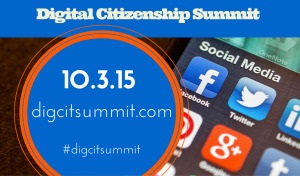 Sept. 24, 2015 As a partner organization in the first ever Digital Citizenship Summit October 3, 2015 bringing in thought leaders and stakeholders from the student, parent, educator and industry sphere I’ve been applying my own mental floss to see how the conference will translate challenging and divergent opinions into some “best practices” to “be the digital change.”
Sept. 24, 2015 As a partner organization in the first ever Digital Citizenship Summit October 3, 2015 bringing in thought leaders and stakeholders from the student, parent, educator and industry sphere I’ve been applying my own mental floss to see how the conference will translate challenging and divergent opinions into some “best practices” to “be the digital change.”
As a critical thinker with a penchant for tossing grenades into my own collegial foxholes to raise the bar for bigger and better thinking, I thought I’d query the #DigCitSummit co-founders with specifics rather than tap dance around some of my own concerns.
After all, I’ve gone to the mat with my own advisory board to hold the prism to the light and see multi-faceted angles…that’s what media literacy and analysis is all about.
Beyond the obvious “be kind online” credos imparted through schools which seeds important truths but all too often smacks of gather-round-the-campfire Kumbaya rhetoric, or the catchy and useful THINK acronym about posting, I want to know specifics about how this great convergence of minds will logistically tackle digital citizenship as an active verb applied to a wide array of topics from safety and social media to posting, policy and pragmatic tools that help kids navigate how to be “cyber civil.”
Granted, the need for savvy and ethical use of tech is inarguable, and using mass media as a megaphone to amplify this important conversation nationwide is a positive, especially with the passionate personalities of co-founders David Ryan Polgar and Marialice BFX Curran bringing the subject to life.
But how do we keep such a divergent group of stakeholders from tumbling into an echo chamber and “preaching to the choir?” How do we merge the wonks and wisdom into real time solutions hearing and heeding ALL voices and views without watering down solutions into pablum that serves no one?
How will the #DigCitSummit implore stakeholders to have a “solutionary” mindset considering alternate views without judgmental underpinnings? This post frames the co-founders positioning of the summit quite well: “We shouldn’t assume people know what digital citizenship IS!”
Can we hold humanity in possibility while simultaneously addressing plausible prevention to curb potential for bullying?
Using the Facebook “Dislike” button as a top of mind example, how will the #DigCit pros effectively debate such key issues?
 Industry insiders like tech columnist Larry Magid declare the intent of the proposed “dislike” button is for empathy functionality, meanwhile opinion pieces like this snarkfest, lambast the entire notion of empathy as drivel, disappointed that there’s no way to let one’s ‘petty flag fly.’
Industry insiders like tech columnist Larry Magid declare the intent of the proposed “dislike” button is for empathy functionality, meanwhile opinion pieces like this snarkfest, lambast the entire notion of empathy as drivel, disappointed that there’s no way to let one’s ‘petty flag fly.’
Toss in expert analysis of media psychologists like Pamela Rutledge and profound parental concerns about bullying by respected colleagues like Diana Graber, cyber civics program creator, our partner org at Cyberwise and a presenter at #DigCitSummit, who minced no words in her HuffPo piece, “Do We Really Need Tools That Make Spreading Meanness Easier?” and this thoughtful parenting post by McAfee Family Safety’s Toni Birdsong and you’ve got quite a stakeholder challenge!
How do we bring together stakeholders that often agree to disagree? Who gets to call the shots?
We ALL are concerned with #digcit yet have VERY different pro/con lenses on these touchpoints…and varying ideas on solutions, for example, the I Can Helpline for schools to triage social media scenarios without heavy-handed over-reaction.
The Digital Citizenship Summit (full schedule here) is an opportunity to bring brilliant minds to the table and ask how we can effectively debate key issues like this and uncork a productive conversation. Here’s how to join in.
On Facebook itself today, opportunistic and nefarious hacker scams have already infiltrated the platform using the ‘dislike button’ as a faux draw with invitation teasers for early adopter testing but c’mon, does that mean the internet is a ‘bad/evil’ place just because there are mischief makers meddling with the community? (Insert gargantuan eyeroll from all of us in the youth and #digcit sphere here.)
Should Facebook use their accessibility ‘empathy lab’ as a model to pilot and test best practices before going live? Could tech titans be called upon to create a different icon than a ‘thumbs down’ if support and empathy is the intent? What would a virtual ‘hug’ or an ‘empathy’ emoji look like as a global, universal symbol?
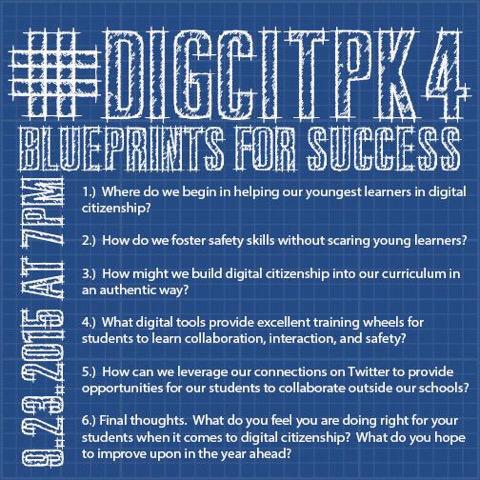 Mind you, some will argue a click of an icon is not the best way to express empathy or digital citizenship of ANY kind, but again…I’d check the personal bias and simply ask a TEEN that question!
Mind you, some will argue a click of an icon is not the best way to express empathy or digital citizenship of ANY kind, but again…I’d check the personal bias and simply ask a TEEN that question!
I’ve seen a texted flower emoji or a Skype bear hug animation from afar bring light and smiles like a love tap that says “hey, I care” or “you matter” or “thinking of you”…In fact, there’s a mental health program experimenting with ‘abuse emoji’ icons to outreach to kids and get them talking.
And what about visual communication so often used early on with wee ones? How young can kids be to embrace #digcit at every age and stage? Even if they’re not even playing in the digital sandbox? (see Marialice’s chat stream Qs at left with educators and parents sharing #digcit tips for tots)
Will there be hearty debate at the #DigCitSummit about protectionism, addressing our cultural propensity to bubble wrap kids with sanitized social media sincerity in the name of safety? What about mental health and social exclusion, can the same icons be used to uplift and inspire? The conversation is already getting started…add your two cents in the DigCitSummit Twitter stream or sign up to follow #DigCitSummit via email.
#DigCitSummit: Part One Prequel
Amy Jussel, Shaping Youth: Using the Facebook “dislike” button as a prototype question up for debate, how will the conference address context and concerns of potential misuse while embracing all four main categories of stakeholders to hear their voices and views through different lenses with solutions-based thinking? What does that ‘outcome’ look like to glean “best practices?” (sidebar: all emphasis areas in blue below are mine)
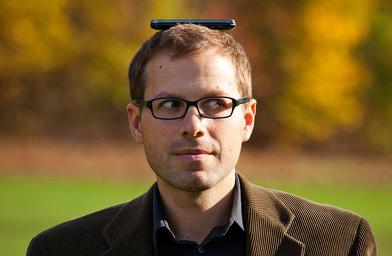 David Ryan Polgar #DigCitSummit: I view the Digital Citizenship Summit as a valuable way to have a fluid conversation about improving the way that we utilize technology. Behind that statement, however, is a major question. What does improving tech use mean?
David Ryan Polgar #DigCitSummit: I view the Digital Citizenship Summit as a valuable way to have a fluid conversation about improving the way that we utilize technology. Behind that statement, however, is a major question. What does improving tech use mean?
All stakeholders are a different from of reference and oftentimes wildly different ideas. I welcome the heated conversations and find that a healthy part of the process. The Digital Citizenship Summit is working hard not to be overly homogeneous. The Facebook ‘dislike’ button is a prime example. We should have an argument over it.
Facebook is well aware that they have become the modern public square and people relate to it as a public utility. There is a very strong emotional attachment with it that is atypical of our normal relationships with business. In most business relationships we take a “if you don’t like it, leave it” approach. That’s not the case with Facebook. Nobody wants to leave a location where most of their friends are, so we take any change of its environment very seriously.
“One area that I am really focused on is diversity of thought.”
I hope to always be smart enough to realize that I don’t have all the answers. I strongly feel that we can reach a better conclusion by having impassioned arguments fight it out. It’s the whole marketplace of ideas concept. By bringing together a diverse range of people into the Digital Citizenship Summit, I am confident that we can reach better conclusions.
The Digital Citizenship Summit will be working on ways to mine the wisdom of its participants. The goal is that it operates as a flock of birds as opposed to a top-down hierarchy of notes. While the Summit is featuring some incredible talent as speakers and panelists, I am also optimistic that everyone attending can influence the conversation. How? By presenting their thoughts to the speakers, by mingling with others.
The interests of all stakeholders will be reflected in the composition of the attendees, as opposed to any type of formalized system. In the future, it would be interesting to have hot issues laid out and then give the general consensus from different stakeholders. For example, educators often have dramatically different feelings on technology than parents do. This is presenting a major issue since the line between when school ends is incredibly blurry with social media’s 24/7 impact.
Amy Jussel, Shaping Youth: So…Who is coming? Can you give specifics on the percentage of each stakeholder group in the audience represented at the summit? What’s the diversity like among industry, parents, educators, students? Given the challenge of silos how do you plan on funneling best practices into actionable steps to “be the digital change?”
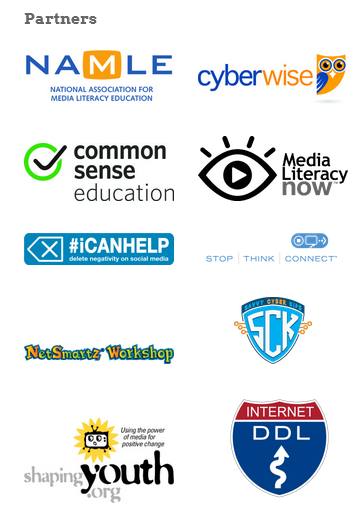 DRP #DigCitSummit: An actionable item right off the bat is a better sharing of materials. We seem to constantly be reinventing the wheel, as opposed to utilizing each other’s high-quality content. If we were able to create a widely-used hub, this could be incredibly valuable. Then instead of merely mental floss, the Digital Citizenship Summit would serve as a physical way to connect, argue, and collaborate. And online, the Digital Citizenship Summit would serve as a repository for this evolving issue.
DRP #DigCitSummit: An actionable item right off the bat is a better sharing of materials. We seem to constantly be reinventing the wheel, as opposed to utilizing each other’s high-quality content. If we were able to create a widely-used hub, this could be incredibly valuable. Then instead of merely mental floss, the Digital Citizenship Summit would serve as a physical way to connect, argue, and collaborate. And online, the Digital Citizenship Summit would serve as a repository for this evolving issue.
After October 3rd, we will have a better idea as to the numbers from each stakeholder group. We will also make adjustments as needed to ensure that we are serving the interests of those groups. For example, a few people have expressed to me that in 2016 they would like to see more students and media specialists involved as speakers. I love to receive feedback and constructive criticism. Keep it coming.
All of the participants of the Digital Citizenship Summit will be playing an active role in shaping its future by filling out a short suggestion form. In addition, we will be using this event as an opportunity to gather ideas and locate patterns. What is your definition of digital citizenship? What does Be the Digital Change mean to you? The responses to these questions, which will be shared with the digital citizenship community at large after October 3rd, should provide a great deal of insight.
Teenagers and social media is an area that we’ll be exploring more head-on in future years. While I talk and give commentary about teenage social media usage, it is still filtered through my frame of reference. I am 36, and as such I still had a relatively analog youth. My very conception of the Internet is far different from a teen. Similar to the historical folly of women’s issues be decided by a room full of men, we want to ensure that the right voices are inserted into the conversation.
I think it’s important to view digital citizenship as an evolving issue–and not get hung up by change. For example, let’s imagine you attended a conference regarding healthy eating. What is healthy eating? It is important to eat healthy, but the elements that make up “healthy eating” are changing based on new research that is coming out. Likewise, digital citizenship is an moving issue instead of being static.
The very goals of the Digital Citizenship Summit will also evolve as it grows and ages, after all, this is the inaugural. Personally, I find that a major issue right now is that we are operating it separate silos. If the Summit create a better line of communication between all of the stakeholders, that’s a very significant accomplishment.
Amy Jussel, Shaping Youth: Thanks for your time David, looking forward to more Q&A in Part Two.
I love the crowdsourcing idea of compiling what works and what doesn’t in the home, classroom and in the media business itself to get beyond curriculum and taxonomy…
In fact, I know the #DigCit chat is separate from the first ever Digital Citizenship Summit, but I joined in this past week with Marialice and found tips like the arts and crafts ‘masks’ for wee ones to explain about usernames and handles was a classic example of early digital citizenship that’s both fun and effective.
Great ideas and hands-on ways to address social exclusion, anonymity and safety with younger kids without fueling fear-based narratives in the social media sandbox. Hope the summit will be flourish with a similar idea exchange…
Part Two forthcoming…stay tuned…
Visual Credits: FB dislike graphic: Sean MacEntee/Flickr, all screenshots from DigCitSummit.com
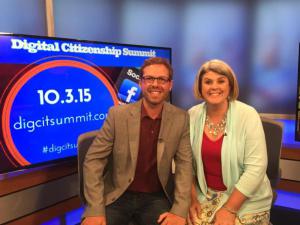








Speak Your Mind